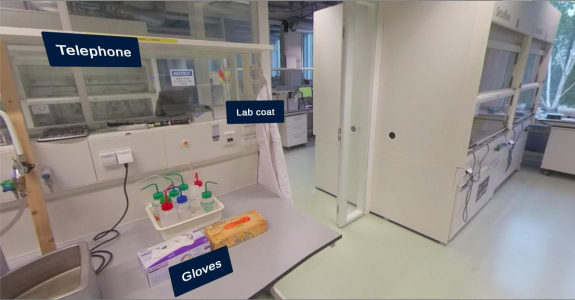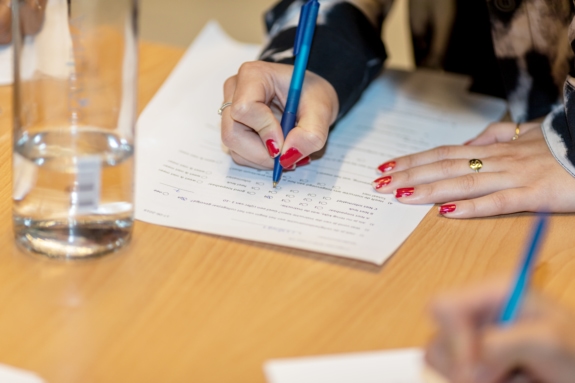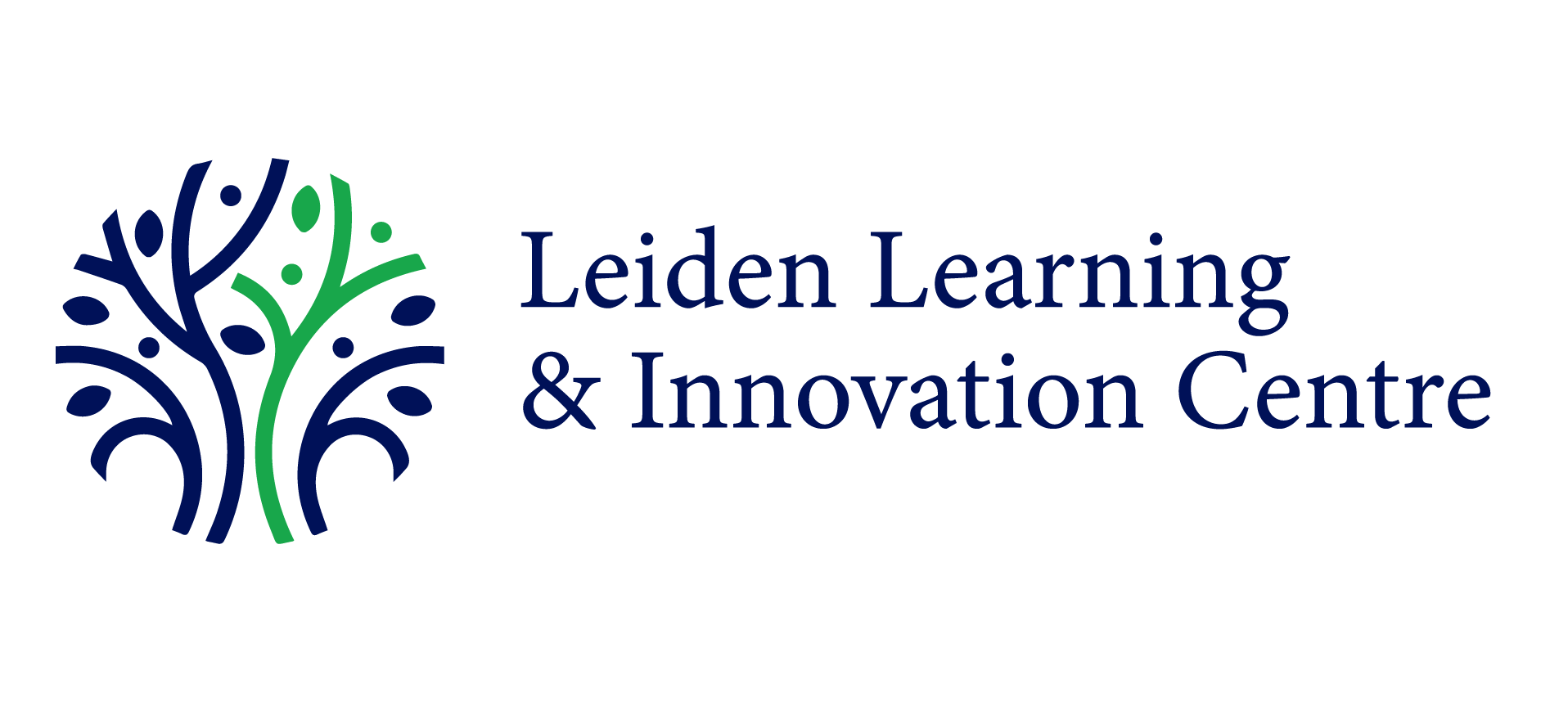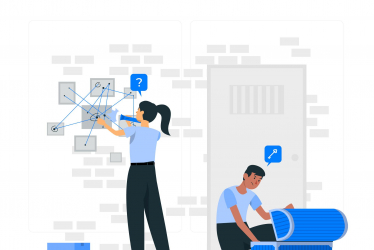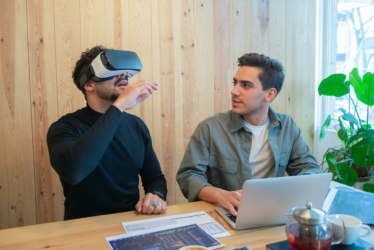Projects
Lab Safety: VR for critical decision making
Laboratories, especially those used for teaching and learning, contain inherent dangers and hazards. Teachers in a lab environment are thus confronted with the simple question: How can one teach students how to work in a lab which they are not allowed to enter until they are familiar with safety procedures? In the developed training module Lab Safety, students can now practise decision making in critical situations in a realistic but safe way.
The Safety Department of the faculty of science at Leiden University, advises the faculty on issues, performs inspections and provides safety training for lab technicians. Students who are going to work in one of the many laboratories at Leiden University must learn how to work safely with these hazards in order to prevent injury to themselves and others around them. We therefore built the VR app Lab Safety, that will become part of the training module for Leiden University science students. We work with digital technologies to solve learning and teaching challenges, and Lab Safety is one of our VR/AR pilot projects. These pilots test the feasibility and effectiveness of immersive technologies for the classroom.
Lab Safety | Project Details
Partner: Faculty of Science, Safety Department: Andre Kamp (Biological Safety Specialist, initiator) and Jeroen Haars (Health, safety and environment Coördinator)
Main target group:First-year students of Biology, Chemistry and Physics attending their compulsory safety training.
This project is a result of the 360° VR Pilot Program that was initiated by LLInC (at that time known as the Centre for Innovation) in 2017. The program aim was to explore the potential of 360° video based VR experiences for teaching and learning in academic education. After selection, six pioneering applicants from different faculties at Leiden University were invited to take part. In each project, the applying faculty members acted as partner and together with the Centre for Innovation created an innovative learning experience for their educational challenge. Read more about the 360 VR Pilot here.
Main educational challenge
New students have to be aware of safety measures before they are allowed to enter a lab. However, to really understand safety instructions and to be able to apply them in practise, students need some lab experience. This is a catch-22 that the safety team at the Faculty of Science of Leiden University is constantly confronted with.
The main challenge for this project was to build a bridge between theoretical knowledge gained through safety training and to actually apply the theories in the lab. The CFI worked with safety trainers who wanted to give students a chance to immediately apply studied safety rules in a fail-safe environment. This would allow students to practise relating theoretical knowledge to the target environment; making them more comfortable in decision-making during critical safety moments; increasing awareness of the importance of safety protocols; and taking appropriate precautions before starting to work in a lab. When a student is conscious of the properties of the laboratory environment there is less chance he or she poses danger to the environment and visa versa. From this consciousness, students gain insight how to take effective measures to prevent dangerous situations.
Your lab buddy spilled a chemical in his eye, what do you do?
The VR app Lab Safetyis based on interactive 360° video, exposing the user to different critical situations in a lab, that could not be emulated during safety drill scenarios. 360 VR° as a new medium offers students the feeling of being present at an experiment. In the application Lab Safety, the user finds themselves in a science lab where he or she will be conducting an experiment together with a co-student, Harry. In this application, users cannot influence the course of the story itself. The interaction lies in defining the right actions to take before they actually happen. At the most crucial moments, the video pauses and the user is confronted with a decision question that he or she needs to answer correctly before the story continues. E.g.: “Do you take the bottle”. Answers: A: “Yes the bottle has just been cleaned so it is safe to do so”, B: “No, I cannot take the bottle because it is potentially contaminated during the accident before.” After providing the correct answer, the user receives textual explanation on the decision and the movie continues.
The story line was developed in such a way that most essential protocols are addressed and the overall experience builds up from light issues to relatively disastrous scenarios. The user journey starts with an introduction to the lab’s safety equipment and ends with an accident caused by a careless student. With this app, students learn the reason behind taking basic precautionary measures, how to handle in case of emergency and many other safety rules. Above all, they practise to apply theoretical knowledge in potentially stressful situations they may encounter during their future career as a lab technician in a safe, repeatable and scalable way.
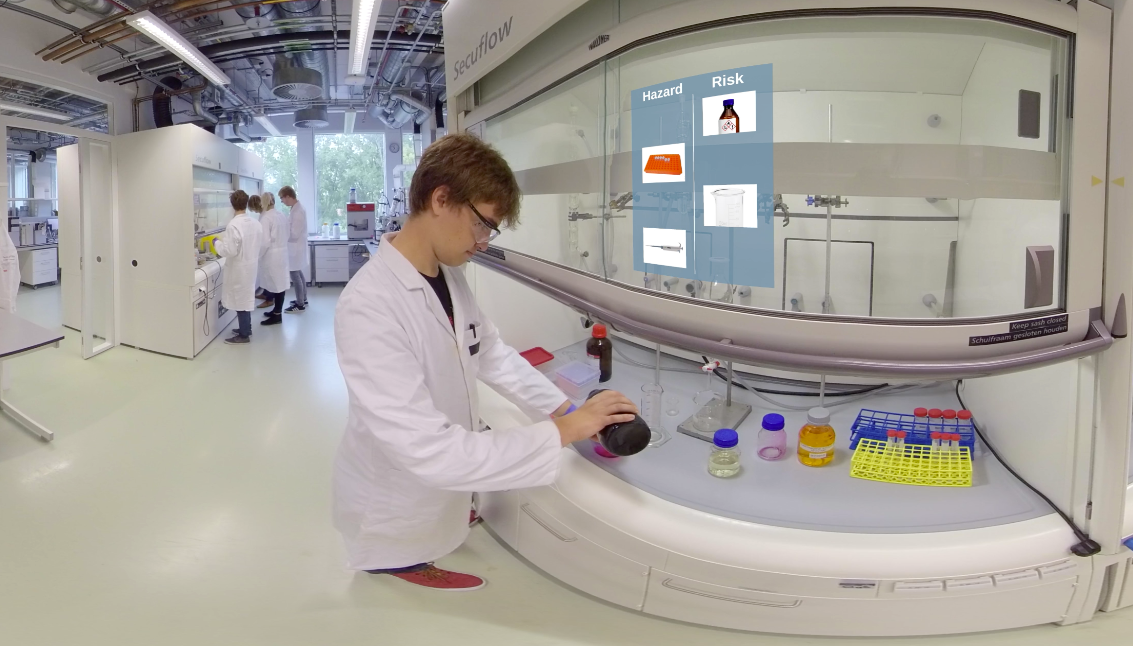 To explain the concepts ‘hazards and risks’, an indicator shows the status of each object involved in the experiment conducted in the first scene.
To explain the concepts ‘hazards and risks’, an indicator shows the status of each object involved in the experiment conducted in the first scene.Audio as stress inducer in critical-situation simulation
One of the main design challenges our team had, was to come up with a method to turn abstract concepts, such as risk assessment and distinguishing betweenhazards and risks, into a concrete experience. This experience needed to captivate students and motivate them to consciously observe their activities and surroundings. Understanding the need to constantly assess risks is one thing, but actually doing this while at work and concentrating on an experiment, gives risk analysis a whole other dimension. We came up with a method of providing students with decision-based questions while they take in the role of a lab buddy in an experiment. Every time critical action should be taken, the user is prompted with a question asking him or her to decide the correct way to proceed. This application is built to support students interpretive abilities. This means that when using the app and when confronted with a question, users must first reflect on what had happened before and then assess what could happen after. The user must then interpret the situation and choose possible answers to the question. In this way, it is assured that the experience is about applying protocols, not about memorising them.
To simulate the stress factor that would be present in a real lab situation during an incident, a timer is set on the questions. In this way, users are motivated to think quickly and pick an answer before the timer runs out. The sound of a timer counting down, increases the intensity of the experience. When an answer is incorrect, an intense buzzer sounds and when a correct answer is given a pleasant ‘ping-like’ sound rings and the soundscape returns to a more calm one.
All video footage was initially captured using a 360° stereoscopic camera. As we were filming in a confined space, we could not commit to one of the general guidelines we normally apply when making a 360° video: keep some space around the camera to ease the stitching process (combining the images of different cameras to create a 360° viewing angle). During the development process, we did experience some issues related to stitching and successfully combining video with computer generated assets so that they display compelling way. Therefore, we eliminated the stereoscopy and went for monoscopic video. While stereoscopy may positively affect users’ feeling of presence and the level of perceived realism, we believe that for the purpose of this project, it was more important to focus on the content than let technical issues stand in our way. For applications that require a certain amount of aesthetics, e.g. to support the feeling of presence or emotion induction, the difference between monoscopic and stereoscopic video may be of more importance.
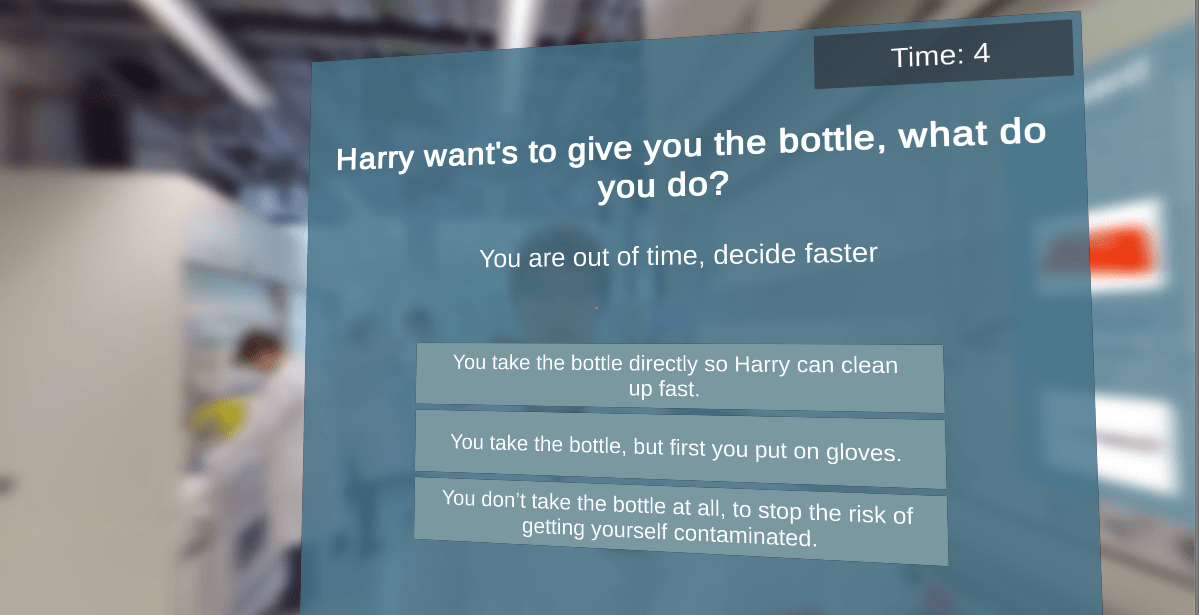 The question panel shown to users at moments critical decisions should be made.
The question panel shown to users at moments critical decisions should be made.Reactions and Implementation
Initial response to the application has been positive. While the application was specifically developed based on the training modules of Leiden University, its potential is wide-spread and other institutes dealing with laboratory safety training have already shown interest.
One of the remaining challenges for the implementation of this project is the organization of the lectures: How can teachers give a lecture with an individual VR experience to many students at the same time? Around a thousand students take part in the yearly safety training, and replacing the original lecture form by VR lessons brings up new challenges.The Safety Department team at Leiden University is now working on finding the best way to organise teaching and learning around lab safety.
The application Lab Safety was tested by Andre Kamp with experts on the topic as well as with non-experts. Results showed that users could reproduce the knowledge that what was addressed in the application right away after use, but also after a longer period (a few weeks to a few months). A formal test on learning outcomes and definition of value compared with traditional educational methods will be conducted from September 2019 onwards, when the Safety Department of Leiden University will start a pilot program to implement the application in their safety training modules.
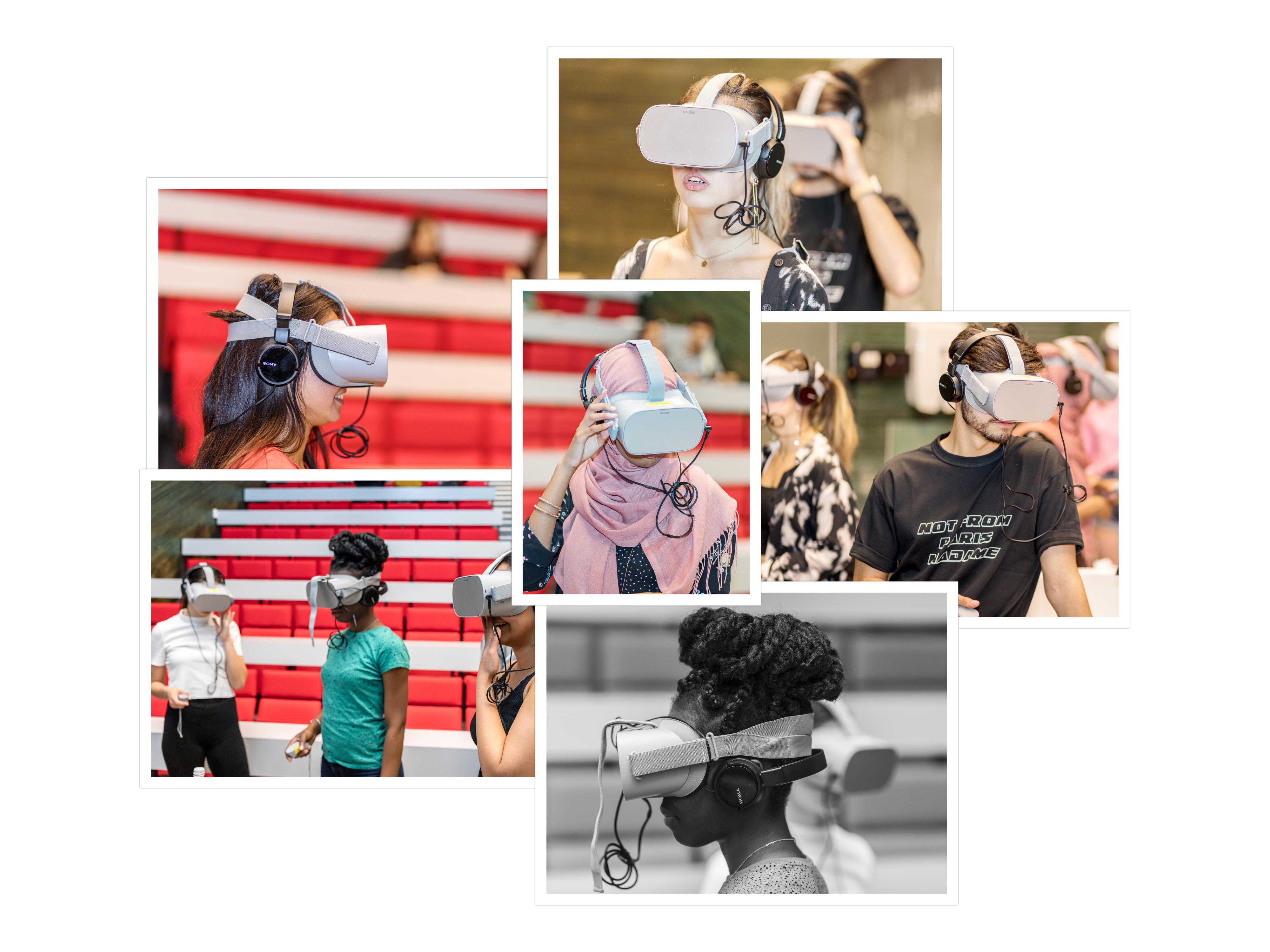 Students viewing the experience during a users test (images by Andre Kamp).
Students viewing the experience during a users test (images by Andre Kamp). 